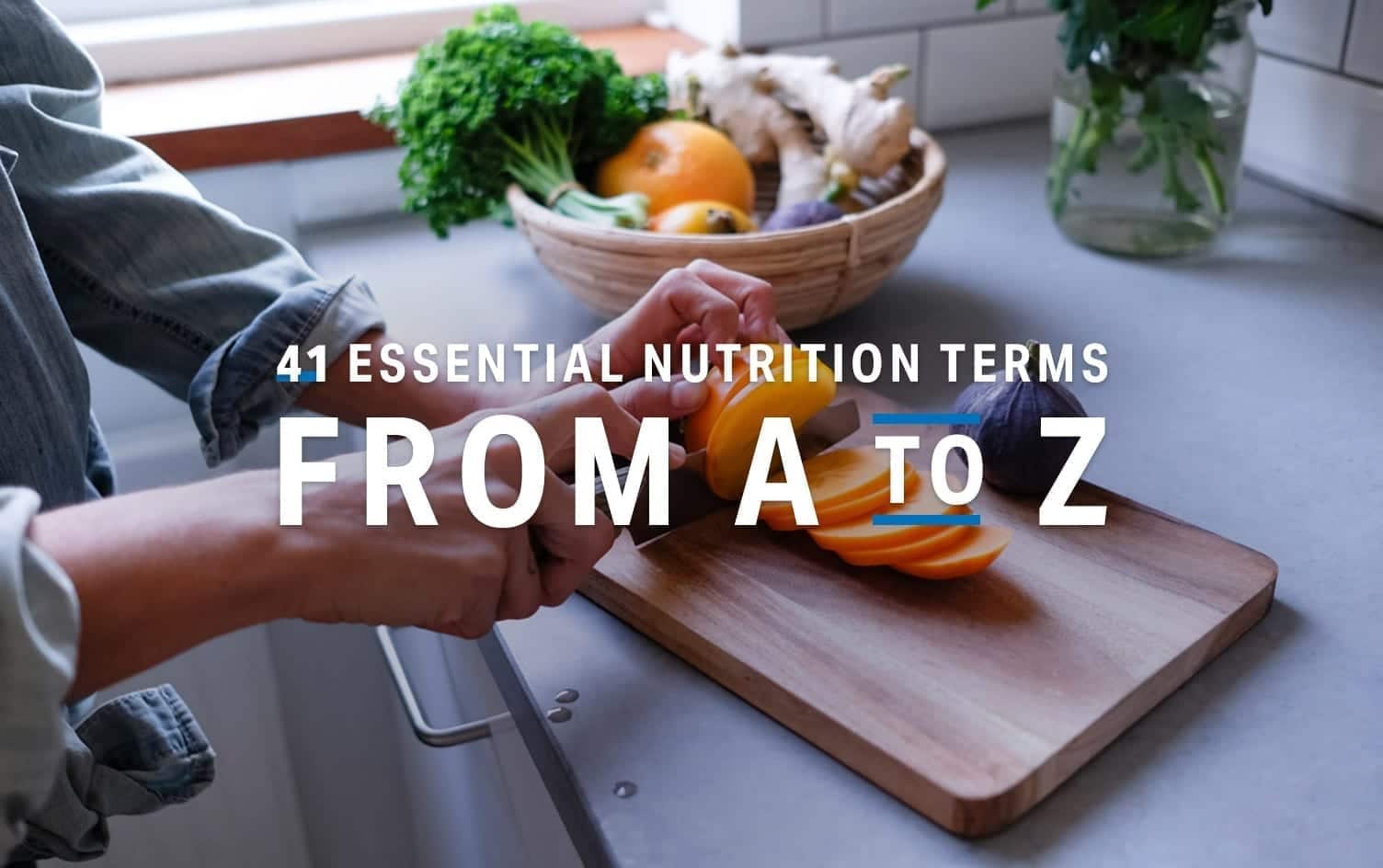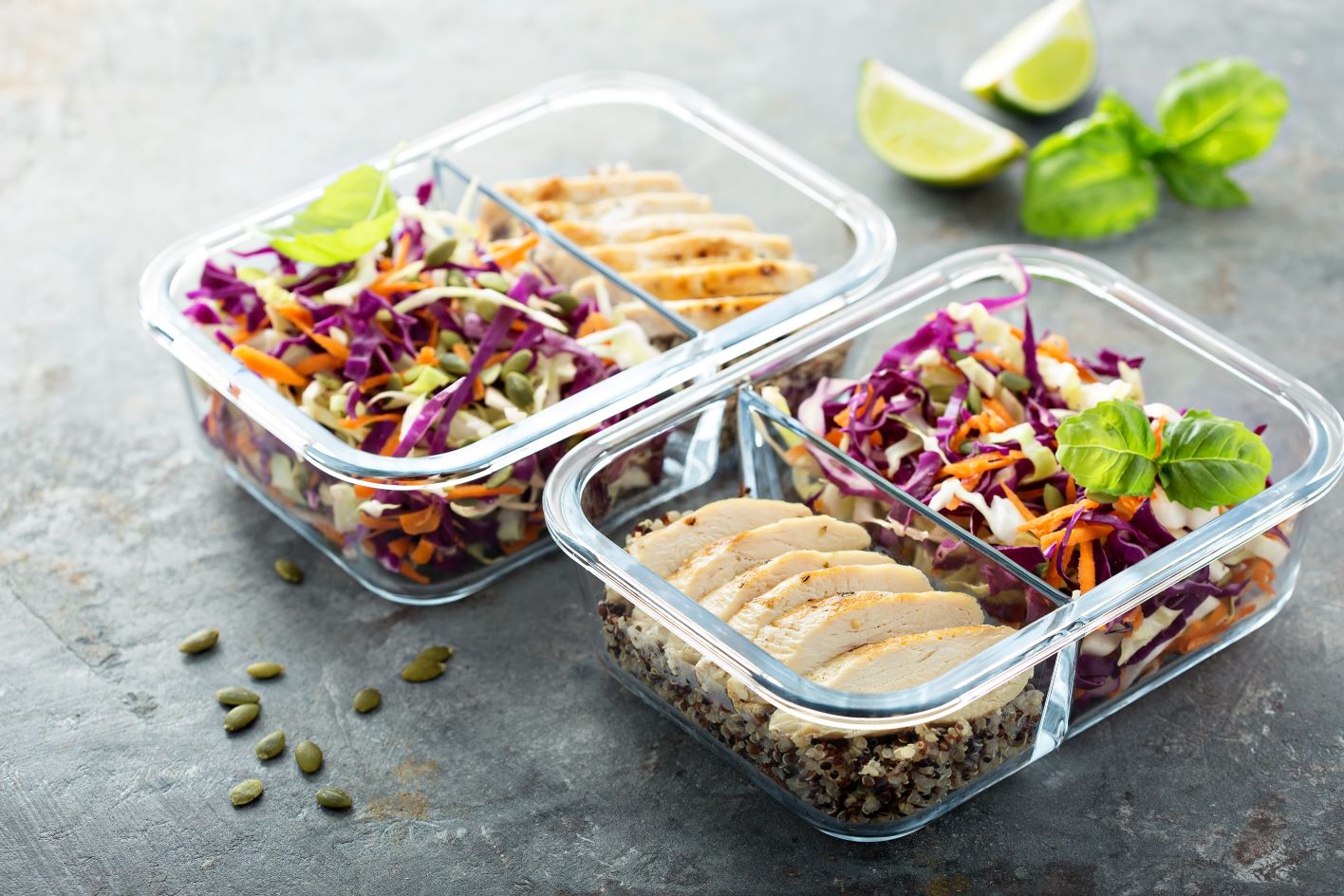Whether you’re trying to shed pounds, eat healthier or build muscle, the world of nutrition can be confusing. If you’re wondering what blood sugar actually is, how to differentiate between “unhealthy” and “healthy” fats or what nutrients do once they’re inside your body, consider this your beginner’s guide.
Read on for the most essential nutrition vocabulary from antioxidants to zinc:
A

Antioxidants are substances that may help protect and repair your cells from damage caused by free radicals, unstable molecules that seem to contribute to aging, cancer and certain diseases. One of the best ways to increase your intake of beneficial antioxidants like vitamin C, carotenoids and beta-carotene is to “eat the rainbow” by filling your plate with a variety of colorful fruits and vegetables.
B

Blood sugar (aka blood glucose) is sugar that enters your bloodstream after you eat or drink, which is then transported all over your body to serve as the main fuel source for your cells. While tracking your blood sugar is a must when you have diabetes, being aware of your blood sugar levels can be helpful for anyone, as high and low blood sugar alike can have detrimental effects.
C

A calorie is a unit that reflects how much energy your body gets from food and drinks. Carbs and proteins provide 4 calories per gram, fat provides 9 calories per gram and alcohol provides 7 calories per gram. If you’ve ever heard “a calorie is a calorie,” know that not all calories are created equal. The way your body breaks down and uses different types of carbs, proteins and fats can vary vastly.

Carbohydrates, aka carbs, are one of the main nutrients your body uses for energy. When you digest carbs, they’re converted into blood sugars which fuel your cells, tissues and organs. Extra sugar is stored in your liver and muscles or broken down and stored as body fat.
There are two categories of carbs: simple and complex. Simple carbs are made of natural and added sugars found in foods like fruit and candy, while complex carbs are made of fiber and starches found in legumes like beans and peas, starchy veggies, like potatoes and corn, whole grains and cereals.

Cholesterol is a fat-like substance your body makes and uses to create vitamin D, hormones and substances that help you digest foods. Like fat, cholesterol doesn’t dissolve in your blood but is transported through your body in the form of lipoproteins (mini fat-protein compounds). Cholesterol is sometimes considered the bad guy because levels of one type (LDL) are linked to an increased risk of heart disease (more on this later).
D

DASH stands for Dietary Approaches to Stop Hypertension; it’s an eating plan that focuses on foods which help decrease blood pressure and reduce the risk of heart disease. It recommends limiting high-sodium foods, sugar and saturated fat and aiming to eat more foods rich in potassium, fiber and protein.

A diabetes diagnosis means you have above normal blood sugar levels because your body doesn’t make enough insulin or use enough of the insulin it makes to help your cells transform glucose into energy.
People with Type 1 diabetes have an autoimmune disorder in which the body mistakenly attacks itself and prevents the production of insulin, while people with Type 2 diabetes produce insulin but don’t make enough or use it efficiently enough to keep blood sugar levels in check. Both types of diabetes are treatable with insulin, blood sugar tracking, medications and regular exercise.
E

Key for major workouts, electrolytes are minerals (like sodium, potassium, magnesium and chloride) your body needs for essential functions like contracting your muscles. In the midst of extra taxing workouts, electrolyte-rich sports drinks, bars and gels can help you replenish your electrolytes.
F

The most calorie-dense macronutrient, fat is essential to help your body absorb fat-soluble vitamins and build healthy cells. Keep reading for the difference between saturated and unsaturated fat.

Fiber is a carb found in plants best known for supporting healthy digestion and making you feel full faster and longer, which could help you lose weight. There are two types of fiber: soluble fiber (which helps control your cholesterol) and insoluble fiber (which helps keep you regular).
High-fiber foods to stock up on: Fruits, like apples, berries and pears; veggies, like carrots, broccoli and artichokes; peas and beans; nuts and seeds and whole grains, like oatmeal and quinoa.
G

Gluten is a mixture of two proteins found in wheat: rye and barley. It has an elastic texture that helps hold foods together and gives bread its springiness. While going gluten-free is a popular diet trend, it may not be necessary unless you have a sensitivity or celiac disease (a rare autoimmune disorder where the body cannot process gluten).

This is a scoring system that measures how much a carb-containing food will raise your blood sugar. Foods and drinks are ranked from 0–100, with high-GI foods causing a sharper spike in blood sugar (pure sugar, for example, is ranked 100) compared to low-GI foods (like veggies and beans), which are higher in fiber.
H

HDL, or high-density lipoproteins, are one of two types of cholesterol. HDL is known as “good” cholesterol, as it picks up extra cholesterol in your bloodstream and carries it to your liver to be broken down.
I

Insulin is a hormone made by your pancreas (an organ tucked behind your stomach) that helps control your blood sugar levels. It allows cells in your muscles, fat and liver to absorb and use sugar, removing it from your bloodstream.

Also called “time-restricted eating,” intermittent fasting (IF) is when you limit eating to a certain time window, often around 8–10 hours. Proponents say it helps with weight loss, improved body composition and decreased cravings, but because it’s restrictive it might not be for everyone.
J

Juicing diets (which often involve green juice) are frequently touted as a magic elixir for weight loss, but many experts warn against them.
K

The keto diet, more formally known as the ketogenic diet, is a high-fat, moderate-protein, low-carb diet that forces your body into ketosis (where fat is burned for fuel instead of carbs). Initially prescribed for people with drug-resistant seizures, the keto diet has become popular for weight loss and Type 2 diabetes management. That being said, it can require significant lifestyle changes and isn’t right (or safe) for everyone.
L

LDL, or low-density lipoproteins, are your “bad” cholesterol, as high levels of LDL can lead to a build-up of cholesterol in your arteries, which, in turn, may increase your risk of heart disease. Foods high in saturated and trans fats (Think: fats that are solid at room temperature, like butter, lard and stick margarines) can raise LDL, which is why experts recommend replacing them with healthier plant-based fats like olive oil.
M

Macronutrients, aka macros, are the three key nutrients your body uses in relatively large amounts: carbohydrates, fat and protein.
If you’re trying to shed pounds or get lean, you may have heard of the “IIFYM” method, or “If It Fits Your Macros,” which allows you to eat whatever you want, as long as you stick to a healthy balance of macros.

The Mediterranean diet places an emphasis on fruits, vegetables, whole grains, beans, seafood and healthy fats like olive oil and nuts. Proponents find it to be a sustainable way of eating and it has proven health benefits such as reducing the risk of heart disease, certain cancers and dementia.

Metabolism is the process your body undergoes to transform the food you eat into energy you can use. While about 60–70% of your daily calories are burned by simply keeping your body running, digesting food and exercising burn about 10% and 20% of your daily calories, respectively.
Just how “fast” or “slow” your metabolism is depends on a number of factors, like your genetics, age, body size, activity and hormone levels.

Micronutrients are nutrients including vitamins and minerals, which your body uses in much smaller amounts compared to macronutrients. That doesn’t mean they aren’t important, though. Your body uses micronutrients for a multitude of essential processes including building new tissues, harnessing energy from food, protecting your cells from free-radical damage and keeping your heart beating.
N

Net carbs are a category of carbohydrates created by food marketers (which is to say, they won’t appear on an official nutrition label). The amount of net carbs in a food is the total amount of carbs minus dietary fiber and sugar alcohols, as neither “count” because they aren’t digested like other carbs. However, this calculation can be more complicated depending on the type of fiber.
O

Oils are fats derived from plants and fish. Depending on the source, the taste and smoke point (the temperature at which they’ll burn) can vary. For example, olive oil is rich in flavor but burns easily (so use it to make a vinaigrette), where nutty peanut oil and more neutral-tasting corn oil are both ideal for high-heat cooking and frying thanks to their high smoke points.

This type of healthy fat is found in fatty fish like salmon as well as walnuts and chia seeds. It has been shown to help lower bad cholesterol levels and protect brain health.
P

High-protein foods include meat, poultry, fish, eggs, dairy products, beans and peas, nuts, soy and some grains.

This term refers to natural chemical substances found in plants (“phyto” is the Greek word for “plant”). By eating a rainbow of foods you will naturally eat more phytonutrients, which can boost your health and help give you an edge in the gym.
Q

An ancient grain, quinoa has one of the highest plant-based protein contents. It’s also a complete source of protein since it contains all the essential amino acids.
R

A registered dietitian, aka RD, is a food and nutrition expert who can give you personalized and trustworthy eating advice. In order to become a RD, someone must first complete coursework approved by the Academy of Nutrition and Dietetics, then finish an accredited, supervised practical program and pass a national exam. After that, RDs regularly complete continuing education to stay up to date and maintain their registration.
S

Also known as sodium chloride, salt, is a mineral your body uses to keep your fluids in balance and your muscles and nerves working. Too much salt (a common problem in the American diet) can increase your blood pressure and put you at risk for heart disease. Consider lowering your sodium intake by cooking more meals at home and tracking your intake with an app like MyFitnessPal.

Butter, cheese, ice cream, chicken skin, bacon, lamb and beef all have one thing in common, besides being delicious: They’re high in saturated fat, the “unhealthy” fat you’re best off limiting. Foods high in saturated fats can raise your “bad” cholesterol and your risk of heart disease, so save them for special occasions and consider healthier alternatives like plant-based oils and frozen “nice” creams.

Sugar is a simple carb found in fruits, vegetables, dairy products and grains. Natural sugars, like those found in fruit, come with nutrients like fiber, vitamins and minerals. Added sugar, on the other hand, tends to be low in nutrients and high in calories. Processed foods like fruit juices, candy and desserts high in added sugar may increase your risk of health issues like weight gain, diabetes and heart disease. That’s why it’s a good idea to limit added sugar in your diet.

Supplements include tablets, capsules, powders, drinks and bars you can use to add vitamins, minerals, herbs, botanicals, amino acids and more to your diet. Keep in mind that supplements aren’t regulated for effectiveness and safety like drugs and may interact with different medications. To be safe, consult with your doctor or a RD first.
T

Triglycerides are a type of fat that can contribute to the hardening and narrowing of your arteries. If you have high triglycerides levels, you may have an increased risk of heart disease, heart attack or stroke. The good news: Tweaking your diet and exercising more can help lower your triglyceride levels.
U

Unsaturated fats are the “healthy” fats that can help lower your “bad” cholesterol levels and reduce your risk of heart disease. They include polyunsaturated and monounsaturated fats found in fatty fish like tuna, mackerel and salmon; olives and avocados; nuts and seeds and plant-based oils like canola, olive, sunflower, peanut and sesame oil.
V

Vitamins are essential micronutrients your body uses to grow and function every day. While most people can get all of the vitamins they need from a healthy, nutrient-dense diet, some people such as vegetarians and vegans, pregnant women and people with chronic conditions may need to take supplements to fill gaps in nutrition.
W

See yo-yo dieting.

Whole grains are exactly what they sound like: grain products made with the entire grain seed (the bran, germ and endosperm). Some examples include 100% wholewheat bread, cracked wheat, oatmeal, brown rice and quinoa.
Many whole grains are a good source of fiber. Conversely, refined grains like white rice, white bread and traditional all-purpose flour have had their natural fiber content removed along with the bran and germ.
X

This food additive acts as a thickener, emulsifier and stabilizer. You’ll often see it in gluten-free packaged goods or keto recipes. Some people may get an upset stomach from xanthan gum, while others may not notice anything, so most experts recommend paying attention to how your body feels after consuming foods where it has been added.
Y

Yo-yo dieting — also known as weight cycling — is a pattern of rapidly losing and regaining weight over and over again, often due to drastic, short-term fad diets you can’t (and shouldn’t) stick with long-term. Because yo-yo dieting can slow your metabolism and even harm your heart health, experts recommend slow and steady weight loss instead.
Z

Your sense of smell and taste are, in part, thanks to zinc, a mineral that also supports your body’s immune system, wound healing, cell growth and the breakdown of carbs. The best sources of zinc are meat and seafood like beef, pork, oysters, crab and lobster. You’ll also find zinc in fortified cereals, beans and nuts.




